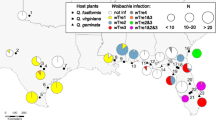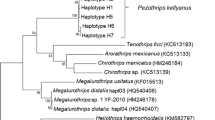Abstract
Harmonia axyridis Pallas (Coleoptera: Coccinellidae) has attracted a growing body of research trying to understand its invasion success in North America and Europe after being introduced from its original range central and east Asia. Its endosymbiotic microorganisms along with the introduction are often assumed to play a potential role in the invasion. We examined the prevalence of three common bacterial groups Rickettsia, Wolbachia and Spiroplasma in H. axyridis populations from 30 geographical locations across mainland China and nine across the Americas. Rickettsia was not detected in both native and non-native H. axyridis populations. Wolbachia infected only one native population at 9.5% but three non-native populations at rates from 3.6 to 25%. All Wolbalchia sequences were aligned to four haplotypes in two groups in the phylogenetic reconstruction. Spiroplasma was not found infecting non-native populations while it infected 15 native ones at rates from 1.6 to 20%. All Spiroplasma sequences were aligned to six haplotypes, among which five were new to H. axyridis populations from China and one was identical to that from Japan. All Spiroplasma lineages in native H. axyridis populations were representative of S. ixodetis. This geographic infection pattern across native and non-native H. axyridis populations suggests that these three groups of maternally-inherited bacteria may not be influential at the initial stages of invasion of H. axyridis in North America.



Similar content being viewed by others
References
Aebi A, Zindel R (2010) What can endosymbionts tell about the Harmonia axyridis invasion? IOBC/WPRS Bull 58:5–6
Ahmed MZ, Li S-J, Xue X et al (2015) The intracellular bacterium Wolbachia uses parasitoid wasps as phoretic vectors for efficient horizontal transmission. PLoS Pathog 11:e1004672
Brown PJ, Thomas C, Lombaert E et al (2011) The global spread of Harmonia axyridis (Coleoptera: Coccinellidae): distribution, dispersal and routes of invasion. Biocontrol 56:623–641
Brown PMJ, Adriaens T, Bathon H et al (2008) Harmonia axyridis in Europe: spread and distribution of a non-native coccinellid. Biocontrol 53:5–21
Cheng CH, Wickham JD, Chen L et al (2018) Bacterial microbiota protect an invasive bark beetle from a pine defensive compound. Microbiome 6:132
Dyson EA, Hurst GDD (2004) Persistence of an extreme sex ratio bias in a natural population. Proc Natl Acad Sci USA 101:6520–6523
Eleftherianos I, Atri J, Accetta J et al (2013) Endosymbiotic bacteria in insects: guardians of the immune system? Front Physiol 4:46
Elnagdy S, Majerus MEN, Handley LJL (2011) The value of an egg: resource reallocation in ladybirds (Coleoptera: Coccinellidae) infected with male-killing bacteria. J Evol Biol 24:2164–2172
Elnagdy S, Majerus MEN, Gardener M et al (2013) The direct effects of male killer infection on fitness of ladybird hosts (Coleoptera: Coccinellidae). J Evol Biol 26:1816–1825
Engelstadter J, Hurst GDD (2007) The impact of male-killing bacteria on host evolutionary processes. Genetics 175:245–254
Feldhaar H (2011) Bacterial symbionts as mediators of ecologically important traits of insect hosts. Ecol Entomol 36:533–543
Frago E, Dicke M, Godfray HCJ (2012) Insect symbionts as hidden players in insect–plant interactions. Trends Ecol Evol 27:705–711
Goryacheva I, Blekhman A, Andrianov B et al (2017) Heritable bacterial endosymbionts in native and invasive populations of Harmonia axyridis. Biol Invasions 19:493–502
Goryacheva I, Blekhman A, Andrianov B et al (2018) Spiroplasma infection in Harmonia axyridis - Diversity and multiple infection. PLoS ONE 13:e0198190
Goryacheva I, Blekhmanb AV, Andrianova BV et al (2015) Genotypic diversity of Wolbachia pipientis in Native and invasive Harmonia axyridis Pall., 1773 (Coleoptera, Coccinellidae) populations. Russ J Genet 51:731–736
Haelewaters D, Zhao SY, Clusella-Trullas S et al (2017) Parasites of Harmonia axyridis: current research and perspectives. Biocontrol 62:355–371
Heddi A, Grenier AM, Khatchadourian C, Charles H, Nardon P (1999) Four intracellular genomes direct weevil biology: nuclear, mitochondrial, principal endosymbiont, and Wolbachia. Proc Natl Acad Sci USA 96:6814–6819
Hilgenboecker K, Hammerstein P, Schlattmann P et al (2008) How many species are infected with Wolbachia? a statistical analysis of current data. FEMS Microbiol Lett 281:215–220
Himler AG, Adachi-Hagimori T, Bergen JE et al (2011) Rapid spread of a bacterial symbiont in an invasive whitefly is driven by fitness benefits and female bias. Science 332:254–265
Hurst GD, Jiggins FM (2000) Male-killing bacteria in insects: mechanisms, incidence, and implications. Emerg Infect Dis 6:329–336
Jiggins FM, Hurst GDD, Jiggins CD et al (2000) The butterfly Danaus chrysippus is infected by a male-killing Spiroplasma bacterium. Parasit 120:439–446
Kajtoch L, Kotásková N (2018) Current state of knowledge on Wolbachia infection among Coleoptera: a systematic review. Peer J 6:e4471
Koch RL (2003) The multicolored Asian lady beetle, Harmonia axyridis: a review of its biology, uses in biological control, and non-target impacts. J Insect Sci 3:1–16
Lombaert E, Guillemaud T, Cornuet JM et al (2010) Bridgehead effect in the worldwide invasion of the biocontrol harlequin ladybird. PLoS ONE 5:e9743
Lu M, Wingfield MJ, Gillette NE (2010) Complex interactions among host pines and fungi vectored by an invasive bark beetle. New Phytol 187:859–866
Lu M, Hulcr J, Sun JH (2016) The role of symbiotic microbes in insect invasions. Annu Rev Ecol Evol Syst 47:487–505
Majerus MEN (2003) Sex wars: genes, bacteria, and sex ratios. Princeton University Press, Princeton
Majerus TMO, Majerus MEN, Knowles B et al (1998) Extreme variation in the prevalence of inherited male-killing microorganisms between three populations of Harmonia axyridis (Coleoptera: Coccinellidae). Heredity 81:683–691
Majerus TM, Graf von der Schulenburg JH, Majerus ME, Hurst GD (1999) Molecular identification of a male-killing agent in the ladybird Harmonia axyridis (Pallas) (Coleoptera: Coccinellidae). Insect Mol Biol 8:551–555
Nakamura K, Ueno H, Miura K (2005) Prevalence of inherited male-killing microorganisms in Japanese population of ladybird beetle Harmonia axyridis (Coleoptera: Coccinellidae). Ann Entomol Soc Am 98:96–99
Raak-van den Berg CL, Hemerik L, van der Werf W et al (2017) Life history of the harlequin ladybird, Harmonia axyridis: a global meta-analysis. Biocontrol 62:283–296
Richard FJ (2017) Symbiotic bacteria influence the odor and mating preference of their hosts. Front Ecol Evol 5:143
Rowe M, Veerus L, Trosvik P et al (2020) The reproductive microbiome: an. Emerging driver of sexual selection, sexual conflict, mating systems, and reproductive isolation. Trends Ecol Evol 35:220–234
Roy HE, Brown PMJ, Adriaens T et al (2016) The harlequin ladybird, Harmonia axyridis: global perspectives on invasion history and ecology. Biol Invasions 18:997–1044
Rozas J, Sanchez-Delbarrio JC, Peypoch XM et al (2003) DnaSP, DNA polymorphism analyses by the coalescent and other methods. Bioinformatics 19:2496–2497
Sazama EJ, Bosch MJ, Shouldis CS et al (2017) Incidence of Wolbachia in aquatic insects. Ecol Evol 7:1165–1169
Sazama EJ, Ouellette SP, Wesner JS (2019) Bacterial endosymbionts are common among, but not necessarily within, insect species. Environ Entomol 48:127–133
Sloggett JJ (2012) Harmonia axyrids invasions: deducing evolutionary causes and consequence. Entomol Sci 15:261–273
Tamura K, Stecher G, Peterson D et al (2013) MEGA6: molecular evolutionary genetics analysis version 6.0. Mol Biol Evol 30:2725–2729
Tinsley MC, Majerus ME (2006) A new male-killing parasitism: Spiroplasma bacteria infect the ladybird beetle Anisosticta novemdecimpunctata (Coleoptera: Coccinellidae). Parasitology 132:757–765
Turgeon J, Tayeh A, Facon B et al (2011) Experimental evidence for the phenotypic impact of admixture between wild and biocontrol Asian ladybird (Harmonia axyridis) involved in the European invasion. J Evolution Biol 24:1044–1052
van Lenteren JC (2012) The state of commercial augmentative biological control: plenty of natural enemies, but a frustrating lack of uptake. Biocontrol 57:1–20
Vilcinskas A, Stoecker K, Schmidtberg H et al (2013) Invasive harlequin ladybird carries biological weapons against native competitors. Science 340:862–863
Weinert LA, Araujo-Jnr EV, Ahmed MZ et al (2015) The incidence of bacterial endosymbionts in terrestrial arthropods. Proc R Soc B 282:1807
Weinert LA, Tinsley MC, Temperley M (2007) Are we underestimating the diversity and incidence of insect bacterial symbionts? A case study in ladybird beetles. Biol Lett 3:678–681
Werren JH, Baldo L, Clark ME (2008) Wolbachia: master manipulators of invertebrate biology. Nat Rev Microbiol 6:741–751
Werren JH, Windsor DM (2000) Wolbachia infection frequencies in insects: evidence of a global. equilibrium? Proc R Soc B 267:1277–1285
Zakharov IA, Goryacheva I, Suvorov A (2011) Mitochondrial DNA polymorphism in invasive and native populations of Harmonia axyridis. Russ J Environ Sci 1:15–18
Zakharov IA, Zinkevich NS, Shaikevich EV et al (1999) Sex ratio and male killing in Siberian populations of Harmonia axyridis (Pass.). Genetika 35:771–776
Acknowledgements
We thank Shaokui Wen, Hehe Cao, Yuyang Sheng, Shulei Tai, Zhentai Ge, Haosen Li, Haitian Song, and Guijian Zhang for their help in the collection of H. axyridis samples in China as well as Edison Ryoti Sujii in Brazil. We also thank Jennifer A. White for the suggestions in writing earlier manuscript draft.
Funding
This research was supported by the National Key R&D Program of China (2017YFD0201000) and the Graduate Program of Research & Innovation of Jiangsu Province (KYCX18_0669).
Author information
Authors and Affiliations
Contributions
Baoping Li and John J. Obrycki contributed to experiments design. Hongran Li and Xiaohan Shu carried out the experiments. Hongran Li analyzed data and draft the manuscript. Hongran Li, Ling Meng, Xuguo Zhou and Baoping Li revised the manuscript. All authors read and approved the final manuscript.
Corresponding author
Ethics declarations
Competing interests
The authors have no competing interests.
Additional information
Publisher's Note
Springer Nature remains neutral with regard to jurisdictional claims in published maps and institutional affiliations.
Rights and permissions
About this article
Cite this article
Li, H., Shu, X., Meng, L. et al. Prevalence of maternally-inherited bacteria in native and invasive populations of the harlequin ladybird beetle Harmonia axyridis. Biol Invasions 23, 1461–1471 (2021). https://doi.org/10.1007/s10530-020-02451-x
Received:
Accepted:
Published:
Issue Date:
DOI: https://doi.org/10.1007/s10530-020-02451-x




